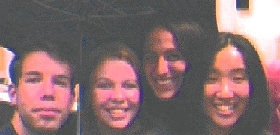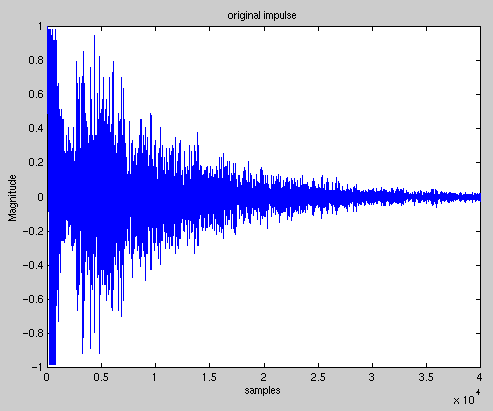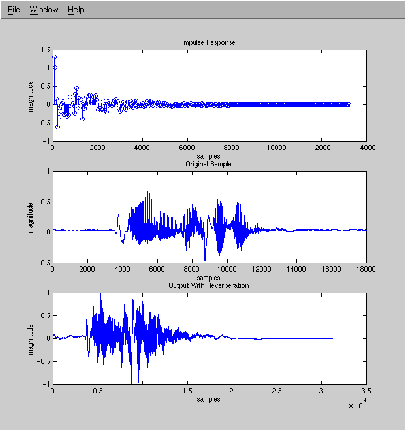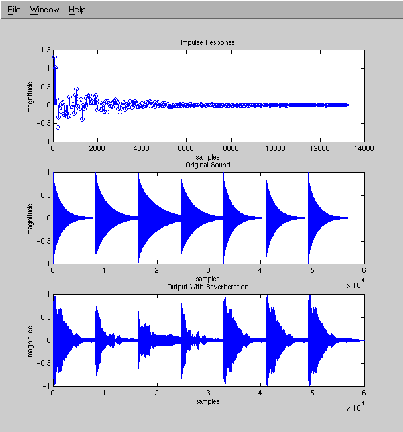



Architects, engineers, physicists, and high-society music enthusiasts
(i.e. artsy-fartsy types) spend large amounts of time, energy, and money
designing rooms with very specific reverberation characteristics. Concert
halls are some of the rooms in which controlling reverberation is most
important. One of the difficulties of designing these halls is that their
reverberation characteristics are constantly changing. The number of
people in the hall has a pronounced effect on the reverberation
characteristics, as does the apparel the people are wearing.(1) (Fur
absorbs much more sound than vinyl, for example.) Thus, the halls must be
designed to have desirable reverberation characteristics for a variety of
situations. Many halls address this problem by installing acoustical banners
along the walls. These banners of absorptive material can be deployed to
reduce the amount of reverberation in a somewhat empty hall or retracted to
increase the amount of reverberation in a full concert hall.
Reverberation has not always been such a significant consideration in
architectural design. There was a time when the impact of a design on
reverberation characteristics was not even considered. As some poor
students and Harvard discovered, ignoring the powers of reverberation can
be very detrimental...
So Sabine took on the challenge. He began taking measurements. He started with just how much sound reflection was in the room. He noticed that once the speaker stopped speaking that the sound continued for about 5.5 seconds. This is what made it so difficult to hear the lecturers because if they went on to the next sentence, the listener would still be hearing the beginning of the previous sentence! He used organ pipes, a stop watch, and some trained auditors as well as compressed air (to keep the level of the sound fairly even) and measured how long it took until you could no longer hear the sound.
This lead him to define the term "reverberation time"--the amount of time -->
--it takes sound to die away, or to drop by 60 dB. This number comes from the fact that normal conversation is about 1 million times above the human hearing threshold. He also measured many other rooms on Harvard's campus to compare the "reverberation time" of each. He found that the reverberation time was largely dependent on the contents of the room as well as the building materials used to construct the room. He noted that "good" concert halls had a reverberation time of about 2 to 2.25 seconds (any less than this would cause the sound to seem "dry") and that "good" lecture halls should have a reverberation time of slightly less than 1 second.
He tested Fogg Lecture room by putting different materials in the room and
covered the walls with a variety of materials. He found that when pillow
cussions were added to the room, the reverberation time was significantly
decreased. He also tested the room with various sized people and noted
that the average person decreased the reverberation time by the same amount
as slightly over six cushions. He also found that by putting felt on the walls significantly decreased the reverb time.
Sabine later helped in the design of Symphony Hall in Boston. Using his
knowledge of the materials in the hall and the volume of the hall, he
could come up with a fairly accurate prediction of the hall's reverberation
characteristics.
Later, instead of using the unit of a seat cushion (as comfortable a unit
as it was), researchers began referring to the amount of sound that would
be lost out of a square foot open window (a perfect swallower of sound).
This unit was named a Sabin (after our friend Sabine). One of the seat
cushions he used is worth 0.7 sabins. One adult sitting in an audience is
worth about 4.7 Sabins. But, as it turns out, a couple really is worth
twice as much as one person (apparently Jill can't read); although this is
a less interesting result, it renews our faith in concert hall ettiquite.(1)
As discussed above, reverberation is an important part of both playing and
listening to music. Now that we are aware of its abundant
importance to physical modeling, we must ask ourselves the fundamental question: "How do we model
it?" There are two main ways to simulate the reverberation characteristics
of a room: physical modeling and impulse sampling. Physical modeling
is a mathematical process, which is along the same lines as the other
segments of our project--physical modeling of a plucked string, and
mathematical modeling of fractional delay. In order to model the reverberation time of a room via physical modeling, we must
know several characteristics of that room; the most important are its size
and
shape, and the materials of which it is made. These values are used in a
series of difference equations to determine the approximate reverberation
time of the room. Impulse sampling is a more hands-on method. It involves
simulating an impulse in the room of interest and recording the response to
that impulse. This recording is assumed to be a fairly accurate estimate
of the impulse response of the reverberation characteristics of that room.
Thus, it can be sampled and used to filter sounds, creating an output that
is at least very similar to the input sound played in the room of interest.
We decided to use the impulse sampling method to implement reverberation in
our project. Initially, physical modeling seemed to be the more logical
choice, since the project does focus on the physical modeling of music, but
there were several factors that stood in our way. First, physical modeling
requires a significant amount of detailed information about the room to be
modeled (sizes, shapes, materials, etc.) that were not readily available to
us and would require too much time with a ruler and a tape measure. In
addition, a set of very complicated, intricate equations is required to
obtain a highly accurate model. Though we were eager to learn all of the
mathematical theory behind reverberation modeling, we did not have enough
time to adequately tackle the subject. Impulse sampling allowed us to
obtain the necessary information (an impulse response) relatively easily
and to quickly transform the result into useful information we could
manipulate to study reverberation.
We used a clap to simulate an impulse since it is the shortest sound we
could make, and it is fairly loud. We wanted to sample a room that had
noticeable reverberation characteristics and that exhibited the
reverberation over a long enough period of time that we were able to hear
and see "echoes" in the impulse response. We experimented with several
different rooms including a Shepherd School practice room, Stude Concert
Hall, and a Will Rice College shower. As we expected, the impulse response
in the practice room showed very little reverberation. We hypothesized
that the reverberation that did appear was due to the dilapidated piano
that rang audibly for nearly a minute after each clap. The shower impulse
response showed quite a bit of reverberation, but it occurred too quickly,
and it was difficult to differentiate one echo from another. This result
is likely due to the fact that the shower is very small, so the echoes
reach the listener (or microphone) much more quickly than in a large room.
To borrow a concept from Goldilocks and the Three Bears, if the
practice room was too dead, and the shower was too live, then Stude Hall
was just right. We obtained an impulse response with distinct echoes. We
would expect Stude to have a pleasing impulse response since it is a
concert hall and was designed to to have a reverberation time that is
pleasing for musical performances. We used a laptop computer to record the
response that resulted when Bryan clapped in Stude Hall. Bryan stood
directly in front of the stage and faced the audience to "perform" his
clap. There were no people in the audience, and the acoustical banners
were fully retracted. The microphone was placed immediately to his right,
so we simulated the response as it would be heard by the sound emittor.
Because the recording equipment used was less than perfect, our impulse
response exhibited some constant high frequency noise. This noise was
probably due to the hum of the computer--Stude is designed to have
no extraneous noise. We used a sound-editing algorithm in Bryan's
midi software to remove the noise. The algorithm simply input a sample of
the noise alone (a time interval during which we were not clapping), took
an FFT of the sample, and then removed the frequency components
corresponding to that FFT from the entire signal. This greatly increased
our ability to see the reverberation peaks in the impulse response.
The resulting noise-reduced impulse response is shown below:
The official reverberation time of Stude Hall is .75 seconds with the
acoustical banners fully deployed and 1.3 seconds with the banners fully
retracted. (3) Since we recorded our impulse response when the banners were
retracted, we would expect our impulse response to drop by 60 dB in
approximately 1.3 seconds. Referring to the above plot of the impulse
response, we see that it has not quite dropped by 60 dB at the right edge
of the graph. Our sampling frequency is 44.1 kHz, so the 4*10^4th sample
(at the end of the graph) corresponds to approximately one second. Thus,
the impulse response appears to die out in the 1 to 1.5 second range, which
is consistent with the 1.3 second time given by important, official,
musical people.
We used this noise-reduced impulse response to create a Matlab function
which inputs a sound vector and outputs a vector of what the original
vector would sound like if played in Stude Hall. The development of that
function, finaldelay.m, is described below.
Here's where we attempt to explain all that we did in our code. I really
hope it all makes sense.
At a high level, the reverb code performs a convolution between the sampled
impulse response we got from stude and the input. However, since the input
size is unbounded, and the impulse response is finite, we used a circular
delay line to make things go faster.
The circular delay line is of size N, where N is the length of the impulse
recorded. The delay line reads in samples from the input, and keeps them
around until N samples later. The output simply is the sum of the elements
in the delay line scaled by the values in the impulse array. For an
efficient implementation of the circular delay line, the delay line was
kept as an
array, with indexes pointing into the array for each of the impulse
points. These pointers will move down the array, and when they reach the
end, they loop around. The pointer corresponding to the initial value in
the Impulse array is where the input is copied into. Since the delay line
is the length of the Impulse, when we go to copy in the next value, we are
assured that the value being written over is a value which is no longer
needed. This pointer movement is implemented by adding one to each of the
pointers, and using a mod of the length of the line to loop around pointers
which have reached the end.
For each sample we output, we need to do an add and multiply for each point
in the impulse. Thus, the complexity of the algorithm would
O(length(x)*length(Impulse)). Since the Impulse length is constant, this
is a linear O(n) algorithm. However, it runs faster if there are fewer
points in the impulse. Thus, we take only a subset of the points in the
recorded impulse. Good time/quality tradeoff is achieved by taking every
50 points. So for the index array I_ptr, each pointer will be pointing to
samples in the delay line which are 50 samples apart.
When we recorded the clap in stude hall, we had the gain on the microphone
set fairly high, so that we could record the returning echos. With the
gain this high, the initial clap clipped, so we can't tell the relative
magnitude of the initial pulse with the rest of the file. We took a
value which sounded best, and ended up scaling the first impulse to be 5.
The Matlab code for finaldelay.m and convert.m is provided below.
We used finaldelay.m to process two sound files. The first, name.au, was
Vijay sharing a philosophical thought: "My name is Vijay." The second,
mary.snd, was the first phrase of "Mary Had a Little Lamb" simulated using
the pluck.c code. The results of both inputs are shown below. Note that,
after processing via finaldelay.m, the vectors are sampled at a rate of 8
KHz, not 44.1 KHz. Thus, all sound vectors shown on the graphs below have
a sampling rate of 8 KHz.
The bottom plot on each image shows the output signal of finaldelay.m. The
reverberation is most clearly visible in "Mary Had a Little Lamb" due to
the periodic nature of the input signal. It is interesting to notice the
significant amount of time that it takes each of the impulse responses to
die out. Reverberation really does exist!
We were very pleased with the results of our Matlab implementation, but
there are few imperfections that should be addressed in order to maintain
our engineering ethics (one of the ABET 2000 requirements). First, we
should note that a clap is not a perfect impulse response. A perfect
impulse response would be infinitely narrow in time and contain all frequencies. A
clap is very short and has many frequencies, but it still has some finite
length and a pitch and is therefore not a perfect impulse. This
is apparent in our sounded output, since it has some smearing and immediate
reverberation at high levels (due to the length of the clap).
Another point that should be noted is that we obtained the impulse response
of Stude Hall at one particular location: directly in front of the center
of the stage. The impulse response will be slightly different at every
location in the hall, since the reverberations are coming from several
locations and directions. Finally, we should note that we are uncertain
about the maximum amplitude of the initial clap (impulse). Because the
original clap clipped, we were required to estimate its magnitude. We did
this by listening to the output for different clap magnitudes and
qualitatively choosing the most accurate one. This may have resulted in
echoes in our simulation that are slightly louder or softer than the actual
Stude echoes, but it does not affect the "meat" of our results.
1. Reverberation
and Acoustics
3. Marty Merritt. Facilities Coordinator and Orchestra Manager, The
Shepherd School of Music.
Introduction

Reverberation -- What Is It (and Why Do I Care?)

Background: Mr. Sabine Saves the Day

It's Jill's Mom!
The Big Question: Physical Modeling or Impulse Sampling?

Our Personal Venture into the World of Reverberation


Matlab Implementation
%x = doit('mary.snd'); % reads in sound output of pluck.cc, scales it,
% and plays it
x = auread('name.au'); % reads in the sound file name.au
% We either read the mary.snd file or the name.au file. We can change this.
plot(x); % plot the original sound file
a = auread('stude-clap.au'); % read in what we're going to sample as
% our impulse response
a = a(4596:length(a)); % cuts out information before the clap
a(1) = 5; % sets initial clap magnitude to 5 (guess of what we thought it was)
a = resample(a,8196,44100); % resamples to 8K.
sr = 50; % sets sample rate to 50. This can be changed
Impulse = convert(a,sr); % samples at rate sr and creates an impulse response
% matrix of sample numbers and sample magnitudes
Impulse = abs(Impulse); % takes absolute value of impulse response (easier
% to deal with)
Imp_Max = max(Impulse(:,1));
I_ptr = Imp_Max - Impulse(:,1) + 1;
subplot(311);stem(Impulse(:,1), Impulse(:,2)); % plots sample number
% vs magnitude
subplot(312);plot(x) % we again plot our original signal to compare later
Delay = zeros(1,Imp_Max); % creates a vector delay of length of the maximum
% sample number
y = zeros(1,length(x)+max(Impulse(:,1))); % output vector of length of signal
% plus length of imp. response that
% is initialized to zero.
for(sample=1:length(y)) % for loop to compute output
if(sample < length(x) ) % if sample is less than length of input
Delay (I_ptr(1)) = x(sample);
else
Delay (I_ptr(1)) = 0;
end
%create output
y(sample) = sum ( Delay(I_ptr)'.* Impulse(:,2) );
%move pointers
I_ptr=mod(I_ptr,Imp_Max)+1;
end
y = y/max(y); % normalize y to +/- 1 range so it can be played by matlab
subplot(313);plot(y) % plot output
function [outmat] = convert(a, sr)
plot(a);
title('original impulse');
as(1) = a(1);
for (i=2:(length(a)/sr))
as(i) = a(sr*(i-1));
end
figure;
plot(as);
title('sampled impulse');
for (i=1:length(as))
outmat(i,1) = i*sr;
outmat(i,2) = as(i);
end
figure;
plot(outmat(:,1), outmat(:,2))
title('outmat');
figure;
plot(outmat(:,1), outmat(:,2));

Results and Discussion
"My Name is Vijay"

"Mary Had a Little Lamb"


References